

This is a massive increase from 2000, when the statistic was 1 in 150 children with Autism. These figures speak volumes as to why the need for awareness and education about accessibility and Universal Design is so critical.
In today’s schools the term “normal” or “average” need not apply. All students are unique in terms of their abilities and gifts. Educators are now recognizing the importance of a diversified curriculum and lesson plans that reach as many learners as possible in a universally accessible environment.
The School Media Center is the perfect place to institute a model for inclusiveness by providing a variety of resources on accessibility and Universal Design. The information in this collection was personally examined by me to ensure these resources are current, credible, and useful in a variety of ways. Here you will garner awareness and inspiration, find teaching materials, journals, books, articles, and tutorials – all geared towards creating accessibility in the school, in the library, and in the community. I have included resources for learning and intellectual disabilities, hearing and vision impairments, ASD, Universal Design and Universal Design in Learning. This collection is by no means complete, but provides a starting point upon which to build. I encourage you to explore these sites and think about how you can contribute, even in small ways.
Sue Austin: Deep sea diving ... in a wheelchair. Blind Student - Ben Underwood is amazing! Famous People with Learning Disabilities. A Day in the Life of Deaf Culture-Part 1. A Day in the Life of Someone who is Deaf, Part 2. Visually Impaired - simulation- walk in their shoes. Autism - simulation - walk in their shoes. Learning Disorder Simulations - See how they feel. A Vision of Students Today. Assistive Technologies for Vision and Hearing Impaired Children. What Is An Intellectual Disability? Libraries and Autism: We're Connected. Meet The Normals - Adventures in Universal Design. 7 Principles of UD. Equal Access: Universal Design of Instruction. Universal Design for Learning. Concepts of universal design and what an accessible course and classroom look like.
The 7 Principles of UDL. Autism Research Institute. Written by Stephen M.
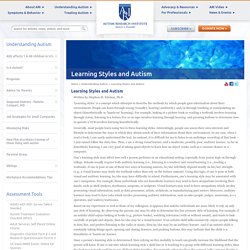
Edelson, Ph.D. 'Learning styles' is a concept which attempts to describe the methods by which people gain information about their environment. Autism Speaks. The Learning Styles of Children with ASD. By Bethany McCabe, MS, OTR/L Both children on the autism spectrum and their neurotypical peers learn best when they are exposed to various learning styles and teaching methods.
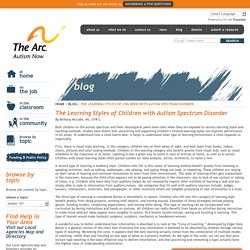
Studies have shown that uncovering and supporting children’s favored learning styles can improve performance in all areas. To understand how a child learns best, it helps to understand what type of learning environment a child responds to organically. First, there is visual style learning. AAIDD - Resources. SpecialEducationGuide.com. NSSLHA - Information for Students. NCLD - National Center for Learning Disabilities.
Life, Animated – Stories of Autism. Positive Exposure Program. DO-IT. South Carolina Assistive Technology Program (SCATP) LD and ADHD. One Place for Special Needs. About Us Dawn Villarreal has two special needs children.
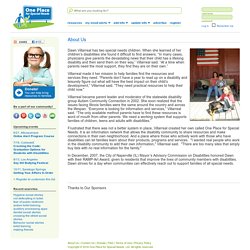
When she learned of her children’s disabilities she found it difficult to find answers. “In many cases, physicians give parents the devastating news that their child has a lifelong disability and then send them on their way,” Villarreal said. “At a time when parents need the most support, they find they are on their own.” Villarreal made it her mission to help families find the resources and services they need. Villarreal became parent leader and moderator of the statewide disability group Autism Community Connection in 2002. Frustrated that there was not a better system in place, Villarreal created her own called One Place for Special Needs.
In December, 2007, the City of Naperville (IL) Mayor’s Advisory Commission on Disabilities honored Dawn with their RAMP-Art Award, given to residents that improve the lives of community members with disabilities. Thanks to Our Sponsors. “50 Best iPad Apps for Reading Disabilities” “50 Best iPad Apps for Reading Disabilities” Guest Blog by Rosa Ray Whether you’re the parent of a child with a reading disability or an educator that works with learning disabled students on a daily basis, you’re undoubtedly always looking for new tools to help these bright young kids meet their potential and work through their disability.

While there are numerous technologies out there that can help, perhaps one of the richest is the iPad, which offers dozens of applications designed to meet the needs of learning disabled kids and beginning readers alike. Here, we highlight just a few of the amazing apps out there that can help students with a reading disability improve their skills not only in reading, writing, and spelling, but also get a boost in confidence and learn to see school as a fun, engaging activity, not a struggle. Talking Calculator. Virtual Manipulatives! Draw Free for iPad. Speak it! Text to Speech. Apple Accessibility. Technology Apps for Learning Disabilities and Issues. Bookshare. Apps for Dyslexia and Learning Disabilities. Microsoft - Accessibility Tutorials. Autism Asperger's Digest.
Children's Books About Disabilities. This list has been sorted by the books' readability levels.

To find what you want, click on a readability grouping below: AC = Adult Read to Children. For Pre-K to Grade 3, ranging from 10 to 30 pages, with illustrations; typically designed for parents to read to their children. JE = Juvenile Easy Reader. For children who are beginning to read on their own, such as those in Grades 1-2; ranging from 30 to 80 pages; illustrations are included to break up the text. JF = Juvenile Fiction. YA = Young Adult. A = Adult. Sarah is a new girl at school who is curious about why Andy spins his yellow frisbee every day by himself on the playground.
Autism Books for Parents and Educators. ADDitude Magazine. Welcome to ADDitude, the leading destination for families and adults living with ADHD and learning disabilities.
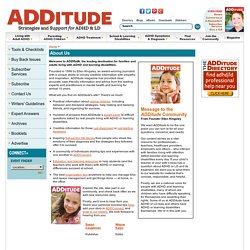
Founded in 1998 by Ellen Kingsley, an award-winning journalist with a unique ability to convey credible information with empathy and inspiration, ADDitude magazine has provided clear, accurate, user-friendly information and advice from the leading experts and practitioners in mental health and learning for almost 10 years. What will you find on ADDitude's site?
There's so much: Special Needs Book Review. Dolly Gray Children's Literature Award. Dolly's full life was in many ways the life of any little girl and young woman.
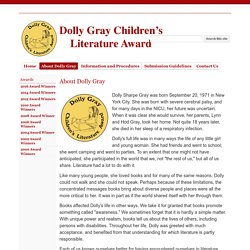
She had friends and went to school; she went camping and went to parties. To an extent that one might not have anticipated, she participated in the world that we, not "the rest of us," but all of us share. Literature had a lot to do with it. Like many young people, she loved books and for many of the same reasons. Dolly could not walk and she could not speak. Books affected Dolly's life in other ways. Project ENABLE- professional online development for teachers, librarians. Text size : Log In or Create Training Account Training Resources Below, we have highlighted resources created by the Project ENABLE team that are used throughout the training modules.
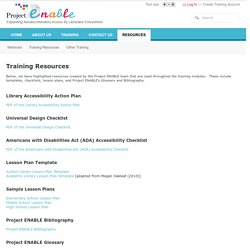
These include templates, checklists, lesson plans, and Project ENABLE's Glossary and Bibliography. Libraries and Autism: We're Connected. The LibrariesScotch Plains Public Library Fanwood Memorial Library Outside Links of Interest We try and keep the focus of the resources we provide here at librariesandautism.org primarily on libraries and service to those on the ASD spectrum and their families, and the areas and topics where the two cross paths, but from time to time we are made aware of other resources that may be of interest to some of our users.We are providing those links HERE.
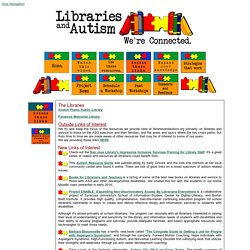
New Links of Interest Check out the San Jose Library's impressive Inclusive Services Training for Library Staff. It's a great series of videos and resources all librarians could benefit from. This Autism Resource Guide was passed along by Kelly Graves and the kids she mentors at her local community center who found it online. Libraries and Autism: We're Connected. Special Needs Project - Collections. Sibling's Voice - VOR. It was a matinee showing of the Broadway play “The King and I” and the excited audience members took their seats.
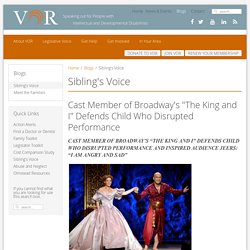
One mother that was attending, however, decided to bring her autistic son with her and hoped that he wouldn’t be a distraction to the other members of the audience. When the play started, however, things. didn’t go as expected. The mother’s son started making a fuss and members of the audience became frustrated. How the crowd reacted, however, shocked Kelvin Loh, one of the actors in the Broadway play. After the play was over, Kelvin went on Facebook in order to collect his thoughts. “I am angry and sad. That being said – this post won’t go the way you think it will. You think I will admonish that mother for bringing a child who yelped during a quiet moment in the show. No. Accessible eBooks. The Learning Styles of Children with Autism Spectrum Disorder.
What Is Autism? Autism, or autism spectrum disorder (ASD), refers to a broad range of conditions characterized by challenges with social skills, repetitive behaviors, speech and nonverbal communication. According to the Centers for Disease Control, autism affects an estimated 1 in 59 children in the United States today. UDL in the ESSA. Date: Wednesday, February 17, 2016 This past December, Congress passed the Every Student Succeeds Act (ESSA), which replaces No Child Left Behind. Collaboration. Five Ways to Collaborate With Families of Students with Disabilities From the Marshall Memo #435 “Families’ involvement in their children’s education stands out as one of the greatest predictors of growth and well-being for students with disabilities,” say Caitlin Edwards (Nashville Public Schools) and Alexandra Da Fonte (Vanderbilt University) in this Teaching Exceptional Children article.
“Not surprisingly, when teachers strive to build working partnerships with families of students with disabilities, home-school collaboration, and, in turn, student achievement increase.” Here is their five-point strategy: • Be positive, proactive, and solution-oriented. Strong bonds with families really matter, all aimed at supporting each child. Working together. Equal Access: Universal Design of Libraries. A checklist for making libraries welcoming, accessible, and usable Libraries play an important role in ensuring that everyone has access to information in printed and electronic forms.
In making these resources accessible and useful to everyone, principles of universal design (UD) can be employed. Legal Issues Section 504 of the Rehabilitation Act of 1973 and the Americans with Disabilities Act of 1990, and the Americans with Disabilities Act Amendments of 2008 prohibit discrimination against individuals with disabilities. According to these laws, no otherwise qualified person with a disability shall, solely by reason of his or her disability, be excluded from the participation in, be denied the benefits of, or be subjected to discrimination under any program or activity of a public entity.
Universal Design Checklist.